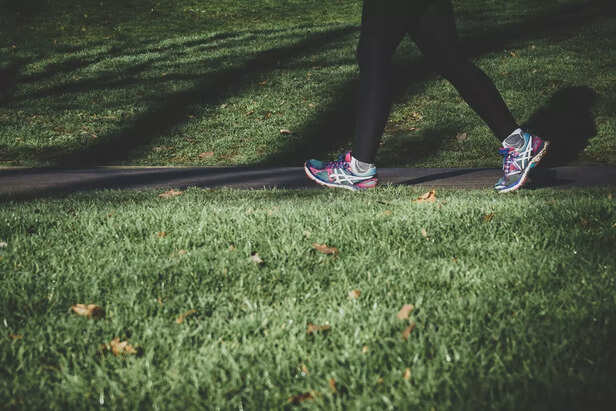Squats vs Walking: Which is Better
Annanya Saxena | Sep 19, 2025, 12:43 IST
Squats vs walking
( Image credit : Unsplash )
Squats and walking both offer unique health benefits, but they serve different goals. Squats shine for controlling blood sugar, building strength, boosting bone density, and saving time, making them perfect for busy people. Walking, however, rules heart health, endurance, stress relief, and long-term mobility. While squats are time-efficient and strengthen multiple muscle groups quickly, walking is joint-friendly and sustainable for all ages. The smartest approach blends both, squats for power and glucose control, walking for cardiovascular fitness and lifelong wellness.
Your workout choice between squats and walking depends on fitness goals plus time plus current health level. Both exercises offer unique benefits but serve different purposes in your daily routine. Research shows squatting beats walking for managing blood sugar levels while walking provides better heart benefits. The winner depends on what you want from your exercise time.

Recent studies prove squats destroy walking for controlling blood sugar spikes after eating meals. Squats work best with just 10 reps being enough because they use more muscle power than walking does. The intense muscle work helps your body burn glucose faster than slow walking ever could.
Because squats recruit more muscle fibers per second than walking they stretch glucose control much further. Just 10 squats provide same blood sugar benefits as 30-minute walk making squats super time-efficient for busy people.
Frequent squat breaks cut post-meal glucose levels more than single 30-minute walks. This happens because squats fire up large muscle groups at once demanding more energy from your body instantly. The muscle burn forces cells to gobble up excess blood sugar quickly.

Walking remains king of heart exercise building cardiovascular strength plus lung power plus stamina over time. Daily walking drops blood pressure plus boosts blood flow plus cuts heart disease risk better than strength moves alone.
A 30-minute daily walk burns steady calories while making your heart stronger without hurting joints. Walking works as lifetime exercise that most people can do for decades no matter what age or fitness level.
The steady rhythm of walking creates calm benefits cutting stress hormones plus boosting mood naturally. Many people enjoy walking more than hard exercises making it easier to stick with long-term.
Walking also provides real-life movement that helps with daily tasks. Strong walking habits improve balance plus coordination plus mobility helping you stay active as you get older.

Squats target multiple big muscle groups creating useful strength that helps with everyday tasks. When done right this exercise burns calories plus prevents injuries plus strengthens core plus improves balance and posture.
Squats work glutes plus thighs plus hamstrings plus core muscles in one move making them extremely time-smart. The multi-muscle nature means you get more strength benefits in shorter sessions compared to walking.
Adding squats to workouts boosts exercise performance plus cuts injury risk plus keeps you moving easily all day long. The strength gains from regular squats improve your ability to lift objects plus climb steps plus rise from low seats.
Squats also build bone thickness better than walking because the weight-bearing nature triggers bone growth. This becomes crucial as you age and bone loss speeds up naturally.

If you have limited time squats deliver more fitness bang per minute than walking does. You get more value doing full squats than cardio training when time becomes tight.
A 5-minute squat session provides strength training plus some heart benefits plus movement improvement. The same 5 minutes of slow walking gives minimal fitness gains for most people.
Squats improve mobility plus increase muscle size plus boost bone density plus enhance core stability in short bursts. Walking needs much longer duration to provide similar fitness benefits across multiple areas.
Busy parents often pick squat workouts because they can finish effective sessions during kids' nap time or TV commercials. The no-equipment nature makes squats possible anywhere anytime.

The best fitness plan uses both squats and walking for complete health benefits. Strength training builds muscle that speeds metabolism while cardio burns calories and makes heart stronger.
Walking gives steady heart exercise your body needs while squats build useful strength your muscles require. Mixing both creates balanced fitness covering heart health plus muscle strength plus bone density plus mental wellness.
Your personal choice depends on current fitness level plus health goals plus time available plus what you enjoy doing. Both exercises offer proven benefits when done regularly over time without fail.
Explore the latest trends and tips in Health & Fitness, Spiritual, Travel, Life Hacks, Trending, Fashion & Beauty, and Relationships at Times Life!
Blood Sugar Battle Winner Takes Squats

How to control blood sugar
( Image credit : Unsplash )
Recent studies prove squats destroy walking for controlling blood sugar spikes after eating meals. Squats work best with just 10 reps being enough because they use more muscle power than walking does. The intense muscle work helps your body burn glucose faster than slow walking ever could.
Because squats recruit more muscle fibers per second than walking they stretch glucose control much further. Just 10 squats provide same blood sugar benefits as 30-minute walk making squats super time-efficient for busy people.
Frequent squat breaks cut post-meal glucose levels more than single 30-minute walks. This happens because squats fire up large muscle groups at once demanding more energy from your body instantly. The muscle burn forces cells to gobble up excess blood sugar quickly.
Walking Rules Heart Health Plus Endurance

Walking daily
( Image credit : Unsplash )
Walking remains king of heart exercise building cardiovascular strength plus lung power plus stamina over time. Daily walking drops blood pressure plus boosts blood flow plus cuts heart disease risk better than strength moves alone.
A 30-minute daily walk burns steady calories while making your heart stronger without hurting joints. Walking works as lifetime exercise that most people can do for decades no matter what age or fitness level.
The steady rhythm of walking creates calm benefits cutting stress hormones plus boosting mood naturally. Many people enjoy walking more than hard exercises making it easier to stick with long-term.
Walking also provides real-life movement that helps with daily tasks. Strong walking habits improve balance plus coordination plus mobility helping you stay active as you get older.
Squats Build Real-Life Strength Fast

Squats build core
( Image credit : Unsplash )
Squats target multiple big muscle groups creating useful strength that helps with everyday tasks. When done right this exercise burns calories plus prevents injuries plus strengthens core plus improves balance and posture.
Squats work glutes plus thighs plus hamstrings plus core muscles in one move making them extremely time-smart. The multi-muscle nature means you get more strength benefits in shorter sessions compared to walking.
Adding squats to workouts boosts exercise performance plus cuts injury risk plus keeps you moving easily all day long. The strength gains from regular squats improve your ability to lift objects plus climb steps plus rise from low seats.
Squats also build bone thickness better than walking because the weight-bearing nature triggers bone growth. This becomes crucial as you age and bone loss speeds up naturally.
Time Crunch Champions Choose Squats

Joint-friendly exercise
( Image credit : Unsplash )
If you have limited time squats deliver more fitness bang per minute than walking does. You get more value doing full squats than cardio training when time becomes tight.
A 5-minute squat session provides strength training plus some heart benefits plus movement improvement. The same 5 minutes of slow walking gives minimal fitness gains for most people.
Squats improve mobility plus increase muscle size plus boost bone density plus enhance core stability in short bursts. Walking needs much longer duration to provide similar fitness benefits across multiple areas.
Busy parents often pick squat workouts because they can finish effective sessions during kids' nap time or TV commercials. The no-equipment nature makes squats possible anywhere anytime.
Smart People Use Both Exercises

Quick squats for strength
( Image credit : Unsplash )
The best fitness plan uses both squats and walking for complete health benefits. Strength training builds muscle that speeds metabolism while cardio burns calories and makes heart stronger.
Walking gives steady heart exercise your body needs while squats build useful strength your muscles require. Mixing both creates balanced fitness covering heart health plus muscle strength plus bone density plus mental wellness.
Your personal choice depends on current fitness level plus health goals plus time available plus what you enjoy doing. Both exercises offer proven benefits when done regularly over time without fail.
Explore the latest trends and tips in Health & Fitness, Spiritual, Travel, Life Hacks, Trending, Fashion & Beauty, and Relationships at Times Life!
